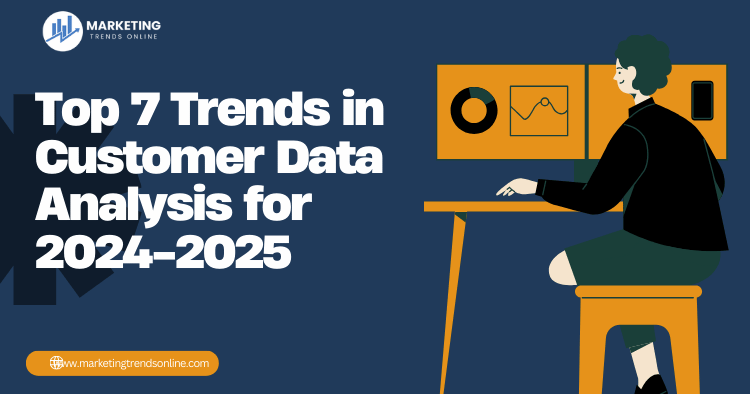Table of Contents
- Introduction
- 1. Enhanced Data Privacy Measures
- 2. Integration of AI and Machine Learning
- 3. Real-time Data Processing
- 4. Predictive Analytics
- 5. Omnichannel Data Strategy
- 6. Data Democratization
- 7. Focus on Customer Experience (CX)
- Conclusion
- FAQs
Introduction
As we step into 2024-2025, the landscape of customer data analysis continues to evolve rapidly. Businesses recognize the value of data in driving decisions, enhancing customer experience, and gaining a competitive edge. However, with these changes come new trends that organizations must adopt to stay relevant and effective. In this article, we will explore the top seven trends that are shaping customer data analysis in the near future.
1. Enhanced Data Privacy Measures
With increasing concerns about data privacy and regulations like GDPR and CCPA, businesses are prioritizing data protection. Organizations are investing in robust security measures and transparency practices to build trust with their customers.
Key Points:
Transparency: Clear communication about data collection and usage is crucial. Customers appreciate knowing how their data is handled.
Data Minimization: Collecting only the necessary data helps mitigate risks and aligns with privacy regulations.
User Consent: Implementing easy-to-understand consent forms empowers customers and fosters trust.
For more on data privacy, check out the International Association of Privacy Professionals.
2. Integration of AI and Machine Learning
Artificial Intelligence (AI) and Machine Learning (ML) are becoming indispensable tools for customer data analysis. These technologies enable organizations to glean insights from vast datasets more efficiently.
Key Points:
- Automated Insights: AI can analyze trends and patterns in data faster than traditional methods.
- Personalization: ML algorithms can tailor customer experiences and recommendations based on past behavior.
- Anomaly Detection: AI helps identify unusual patterns that may indicate fraud or data breaches.
For further reading on AI in data analysis, visit Gartner’s insights.
Also look for the top AI tools revolutionizing data analytics to enhance your data strategies.
3. Real-time Data Processing
In today’s fast-paced environment, real-time data processing is critical. Customers expect businesses to respond to their needs instantly, making the ability to analyze data on-the-fly a significant advantage.
Key Points:
- Instant Insights: Real-time analytics allows businesses to make informed decisions immediately.
- Improved Engagement: By responding to customer interactions in real-time, companies can enhance engagement and satisfaction.
- Operational Efficiency: Organizations can streamline operations by quickly addressing issues as they arise.
For more on real-time processing, check out Forrester’s research.
4. Predictive Analytics
Predictive analytics leverages historical data to forecast future customer behavior. This trend allows businesses to anticipate customer needs and tailor their strategies accordingly.
Key Points:
- Customer Retention: Predictive models can identify customers at risk of leaving, allowing for targeted retention strategies.
- Sales Forecasting: Businesses can better predict demand and adjust inventory or marketing efforts accordingly.
- Targeted Marketing: By understanding potential customer actions, companies can create more effective marketing campaigns.
To dive deeper into predictive analytics, refer to Harvard Business Review.
5. Omnichannel Data Strategy
Customers engage with brands across various channels. An omnichannel data strategy ensures that businesses have a unified view of customer interactions, leading to a seamless experience.
Key Points:
- Holistic View: Integrating data from multiple sources provides a comprehensive understanding of customer behavior.
- Consistent Messaging: Customers appreciate consistent communication across channels, enhancing brand loyalty.
- Cross-Channel Insights: Analyzing customer journeys across platforms helps identify touchpoints that need improvement.
For more insights on omnichannel strategies, check out McKinsey’s research.
6. Data Democratization
Data democratization is about making data accessible to all employees, not just data analysts. This trend empowers teams to make data-driven decisions without heavy reliance on technical experts.
Key Points:
- Empowered Teams: Employees at all levels can leverage data to inform their strategies, leading to innovative solutions.
- User-Friendly Tools: Businesses are adopting intuitive analytics tools that require minimal training.
- Cultural Shift: Encouraging a data-driven culture fosters collaboration and creativity within organizations.
To learn more about data democratization, visit Deloitte’s insights.
7. Focus on Customer Experience (CX)
Finally, as customer expectations continue to rise, businesses are placing a greater emphasis on customer experience. Analyzing customer data to enhance CX is becoming a top priority.
Key Points:
- Personalized Experiences: Leveraging data to offer personalized experiences can significantly boost customer satisfaction and loyalty.
- Feedback Loops: Continuous analysis of customer feedback allows businesses to adapt and improve their offerings.
- Customer Journey Mapping: Understanding the entire customer journey helps identify opportunities for improvement.
For more on enhancing customer experience, check out Forbes.
Also, explore the top content personalization trends for 2024-2025 to enhance customer engagement further.
Conclusion
As we look ahead to 2024-2025, staying abreast of these trends in customer data analysis will be essential for businesses aiming to thrive in a competitive market. By focusing on data privacy, harnessing AI, processing data in real-time, employing predictive analytics, adopting an omnichannel strategy, democratizing data access, and prioritizing customer experience, organizations can position themselves for success.
FAQs
Q1: Why is data privacy important in customer data analysis?
A1: Data privacy is crucial because it fosters trust between businesses and customers. With increasing regulations, organizations that prioritize data protection are likely to attract and retain more customers.
Q2: How can AI improve customer data analysis?
A2: AI enhances customer data analysis by automating insights, personalizing experiences, and detecting anomalies in data, allowing businesses to make quicker and more informed decisions.
Q3: What is predictive analytics?
A3: Predictive analytics involves using historical data to forecast future customer behaviors, enabling businesses to tailor strategies for customer retention, sales forecasting, and targeted marketing.
Q4: What does an omnichannel strategy entail?
A4: An omnichannel strategy integrates customer data from various channels to provide a seamless experience and consistent messaging, enhancing overall customer engagement.
For further exploration of these topics, feel free to explore the links provided throughout the article. Happy analyzing!





